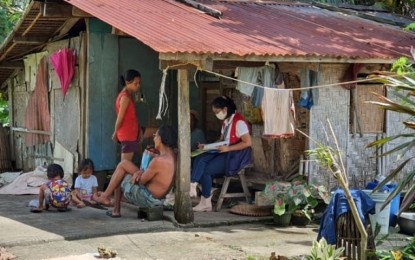
VALIDATION. A social worker interviews members of a household in Palompon, Leyte to update the list of poor families in this Oct. 22, 2021 photo. The Department of Social Welfare and Development is urging government agencies and local government units to use the updated list of poor families in Eastern Visayas as their basis for providing assistance. (Photo courtesy of DSWD)
TACLOBAN CITY – The Department of Social Welfare and Development (DSWD) is urging government agencies and local government units (LGUs) to use the updated list of poor families in Eastern Visayas as their basis for providing assistance.
DSWD 8 (Eastern Visayas) Director Grace Subong said they would share the list with partner agencies and LGUs to guide them in resource allocation.
“We now have a face for each number in the Listahanan (list). This should be the basis for identifying beneficiaries of programs meant to reduce poverty. Under Executive Order No. 867 issued in 2010, DSWD has the responsibility of identifying poor families,” Subong added.
She said agencies should use the list because resources for poverty reduction are limited and assistance should not be wasted.
At least 365,056 families in Eastern Visayas have been identified as poor based on the result of the Listahanan 3 survey as part of the National Household Targeting System for Poverty Reduction.
The number came from the 848,662 households assessed in the survey that began in 2019, which located and identified qualified beneficiaries of the government’s poverty alleviation program.
The list has been validated through the proxy means test, a statistical model that estimates household welfare level based on observable and verifiable proxy indicators of the household’s income, such as materials in housing structure, household’s access to basic services and facilities such as water and electricity, and ownership of specific assets.
The Listahanan uses a unified set of proxy indicators to identify the poor.
This means that the project uses the same indicators for all areas covered by the project, allowing direct comparison among the poverty profiles of different areas, according to the DSWD. (PNA)
